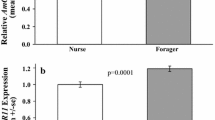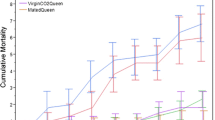Summary
Treatment of 1-day-old worker honey bees with the juvenile hormone analog methoprene prematurely reduced their behavioral threshold sensitivity to alarm pheromones. Electroantennogram assays indicated that peripheral perception was not affected; the effects apparently occurred in the central nervous system. These results support a model (Robinson 1987) of division of labor based on the hormonal regulation of response thresholds to task-associated stimuli. Coupled with other studies (Breed 1983; Robinson 1985), they also suggest that: 1) aggression in the honey bee is hormonally mediated and 2) a single hormone is involved in both the production and perception of an olfactory communication signal, the first report of this phenomenon in an invertebrate.
Similar content being viewed by others
Abbreviations
- JH :
-
juvenile hormone
- CNS :
-
central nervous system
- EAG :
-
electroantennogram
References
Barth RH Jr (1969) Pheromone-endocrine interactions in insects. In: Benson GK, Phillips JG (eds) Hormones and the environment. Cambridge University Press, London, pp 373–404
Bigley WS, Vinson SB (1979) Degradation of [14C] methoprene in the imported fire ant,Solenopsis invicta. Pestic Biochem Physiol 10:1–13
Bjostad LB, Roelofs WL (1980) An inexpensive electronic device for measuring electroantennogram responses to sex pheromone components with a voltmeter. Physiol Entomol 5:309–314
Boch R, Rothenbuhler WC (1974) Defensive behaviour and production of alarm pheromone in honey bees. J Apicult Res 13:217–221
Boch R, Shearer DA, Stone BC (1962) Identification of isoamyl acetate as an active component in the sting pheromone of the honey bee. Nature 195:1018–1020
Breed MD (1983) Correlations between aggressiveness and corpora allata volume, social isolation, age and dietary protein in worker honey bees. Insectes Soc 30:482–495
Breed MD, Bell WJ (1983) Hormonal influences on invertebrate aggressive behavior. In: Savre BB (ed) Hormones and aggressive behavior. Plenum Press, New York, pp 577–591
Collins AM (1979) Genetics of the response of the honey bee to an alarm chemical, isopentyl acetate. J Apicult Res 18:285–291
Collins AM (1980) Effect of age on the response to alarm pheromones by caged honeybees. Ann Entomol Soc Am 73:307–309
Collins AM (1981) Effects of temperature and humidity on honeybee response to alarm pheromones. J Apicult Res 20:13–18
Collins AM, Rothenbuhler WC (1978) Laboratory test of the response to an alarm chemical, isopentyl acetate, byApis mellifera. Ann Entomol Soc Am 71:906–909
Collins AM, Rinderer TE, Tucker KW, Sylvester HA, Lackett JJ (1980) A model of honeybee defensive behaviour. J Apicult Res 19:224–231
Collins AM, Rinderer TE, Harbo JR, Bolten AB (1982) Colony defense of Africanized and European honey bees. Science 218:224–231
Copijn GM, Beetsma J, Wirtz P (1979) Queen differentiation and mortality after application of different juvenile hormone analogues to worker larvae of the honeybee (Apis mellifera L.). Proc Kon Ned Akad Wet C 82:29–42
Davis EE (1984) Regulation of sensitivity in the peripheral chemoreceptor systems for host-seeking behaviour by a haemolymph-borne factor inAedes aegypti. J Insect Physiol 30:179–183
Fluri P, Lüscher M, Wille H, Gerig L (1982) Changes in weight of the pharyngeal gland and haemolymph titres of juvenile hormone, protein and vitellogenin in worker honey bees. J Insect Physiol 28:61–68
Free JB (1965) The allocation of duties among worker honey bees. Zool Soc Lond Symp 14:39–59
Free JB, Winder ME (1983) Brood recognition by honey bee (Apis mellifera) workers. Anim Behav 31:539–545
Freund RJ, Littell RC (1981) SAS for linear models: A guide to the ANOVA and GLM procedures. SAS Institute, North Carolina
Hoy RR, Hahn J, Paul RC (1977) Hybrid cricket auditory behavior: evidence for genetic coupling in animal communication. Science 195:82–84
Hussein MH, Abdel-Aal YAI (1978) Effect of ZR-515 on honeybee,Apis mellifera. Z Angew Entomol 87:109–111
Kandel ER, Krasne FB, Strumwasser F, Truman JT (1979) Cellular mechanisms in the selection and modulation of behavior. Neurosci Res Prog Bul 17:523–710
Lee C, Ingersoll DW (1983) Pheromonal influence on aggressive behavior. In: Savre BB (ed) Hormones and aggressive behavior. Plenum Press, New York, pp 373–393
Maschwitz U (1964) Alarm substances and alarming processes for danger in social Hymenoptera. Z Vergl Physiol 47:596–655
Masson C, Arnold G (1984) Ontogeny, maturation and plasticity of the olfactory system in the worker bee. J Insect Physiol 30:7–14
Robinson GE (1985) Effects of a juvenile hormone analogue on honey bee foraging behaviour and alarm pheromone production. J Insect Physiol 35:277–282
Robinson GE (1987) Regulation of honey bee age polyethism by juvenile hormone. Behav Ecol Sociobiol, In press
Robinson GE, Strambi A, Strambi C, Paulino-Simões ZL, Tozeto SO, Barbosa JMN (1987) Juvenile hormone in European and Africanized honey bees. Gen Comp Endocrinol (in press)
Roelofs WL (1984) Electroantennogram assays: rapid and convenient screening procedures for pheromones. In: Hummel HG, Miller TA (eds) Techniques in pheromone research. Springer, Berlin Heidelberg New York, pp 131–161
Röseler PF (1985) Endocrine basis of dominance and reproduction in polistine paper wasps. In: Hölldobler B, Lindauer M (eds) Experimental behavioral ecology and sociobiology. Sinauer, Stuttgart, pp 259–273
Seeley TD (1985) Honeybee ecology: a study of adaptation in social life. Princeton University Press, Princeton
Shearer DA, Boch R (1965) 2-heptanone in the mandibular gland secretion of the honeybee. Nature 206:530
Southwick EE, Moritz RFA (1985) Metabolic response to alarm pheromone in honey bees. J Insect Physiol 31:389–392
Staal GB (1975) Insect growth regulators with juvenile hormone activity. Annu Rev Entomol 20:417–460
Stort AC (1975) Genetic study of aggressiveness of two subspecies ofApis mellifera in Brazil. II. Time at which the first sting reached the leather ball. J Apicult Res 14:171–175
Stort AC (1976) Genetic study of aggressiveness of two subspecies ofApis mellifera in Brazil. III. Time taken for the colony to become aggressive. Ciên y Cult 28:1182–1185
Szabo TI, Townsend GF (1974) Behavioural studies on queen introduction in the honeybee. 1. Effect of the age of workers (from a colony with a laying queen) on their behaviour towards an introduced virgin queen. J Apicult Res 13:19–25
Tobe SS, Stay B (1979) Modulation of juvenile hormone synthesis by an analogue in the cockroach. Nature 281:481–482
Truman JT (1978) Hormonal control of invertebrate behaviour. Horm and Behav 10:214–234
Truman JT, Riddiford LM (1974) Hormonal mechanisms underlying insect behaviour. In: Treherne JE, Berridge MJ, Wigglesworth VB (eds) Advances in insect physiology, vol 10. Academic Press, New York, pp 297–352
Visscher PK (1983) The honeybee way of death: necrophoric behaviour inApis mellifera colonies. Anim Behav 31:1070–1076
Webster RP, Cardé RT (1984) The effects of mating, exogenous juvenile hormone and a juvenile hormone analogue on pheromone titre, calling and oviposition in the omnivorous leafroller moth (Platynota stultana). J Insect Physiol 30:113–118
Wilson EO (1971) The insect societies. Belknap Press of Harvard University Press, Cambridge
Wilson EO (1985) Between-caste aversion as a basis for division of labor in the antPheidole pubiventris (Hymenoptera: Formicidae). Behav Ecol Sociobiol 17:35–37
Winston ML (1987) The biology of the honey bee. Harvard University Press (in press)
Zdárek J, Haragsim (1974) Action of juvenoids on metamorphosis of the honey-bee,Apis mellifera. J Insect Physiol 20:209–221
Author information
Authors and Affiliations
Rights and permissions
About this article
Cite this article
Robinson, G.E. Modulation of alarm pheromone perception in the honey bee: evidence for division of labor based on hormonall regulated response thresholds. J. Comp. Physiol. 160, 613–619 (1987). https://doi.org/10.1007/BF00611934
Accepted:
Issue Date:
DOI: https://doi.org/10.1007/BF00611934




